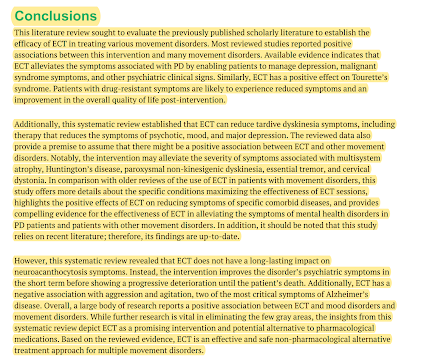ECT For Movement Disorders: New Review
Out on PubMed, from authors in the USA , is this review:
Efficacy of Electroconvulsive Therapy for the Treatment of Movement Disorders: A Literature Review.
Cureus. 2023 Mar 24;15(3):e36634. doi: 10.7759/cureus.36634. eCollection 2023 Mar.PMID: 36968685 Review.
Electroconvulsive therapy (ECT) is a safe and effective treatment modality for various psychiatric disorders. However, evidence suggests a putative role of ECT in treating movement disorders that are refractory to less invasive modalities. ECT is primarily used in treatment-resistant psychiatric disorders. However, growing evidence exists for its use in movement disorders with and without psychiatric comorbidity. The primary objective of this systematic review was to examine the efficacy of ECT as a primary treatment modality for movement disorders. Relevant, peer-reviewed publications were retrieved from PubMed, SCOPUS, CINAHL, and PsycINFO. Keywords related to ECT and movement disorders were used as search phrases to identify relevant articles. A total of 90 articles that met the inclusion criteria were included in this review. Core findings were subsequently appraised on the role of ECT in treating movement disorders. Inclusion and exclusion criteria were developed to guide the search and selection process. Sources that met the inclusion criteria were those published between 2001 and January 2023. Additionally, peer-reviewed journals published in the English language covering the role of ECT in movement disorders were deemed appropriate for inclusion. Sources published before 2001, written in a non-English language, and not from peer-reviewed journals were excluded from this systematic review. The exclusion criteria also entailed eliminating duplicates from the review list. Most reviewed sources revealed that ECT improved outcomes in symptoms associated with various movement symptoms. However, ECT does not have a long-lasting impact on neuroacanthocytosis symptoms. Additionally, ECT is negatively associated with aggression and agitation, two of the most critical movement symptoms of Alzheimer's disease. Evidence affirms the efficacy of ECT in providing symptomatic relief for movement disorders aside from psychiatric comorbidities. This positive association highlights the need for randomized controlled studies to identify movement disorder sub-populations that may respond to ECT.
Keywords: electroconvulsive therapy (ect); movement disorders; psychiatric comorbidities; review article; treatment choices.
The article is here.
And from the text:
That said, the reminder of the benefits of ECT in PD, Tourette's and TD is worth having in the literature.




Comments
Post a Comment